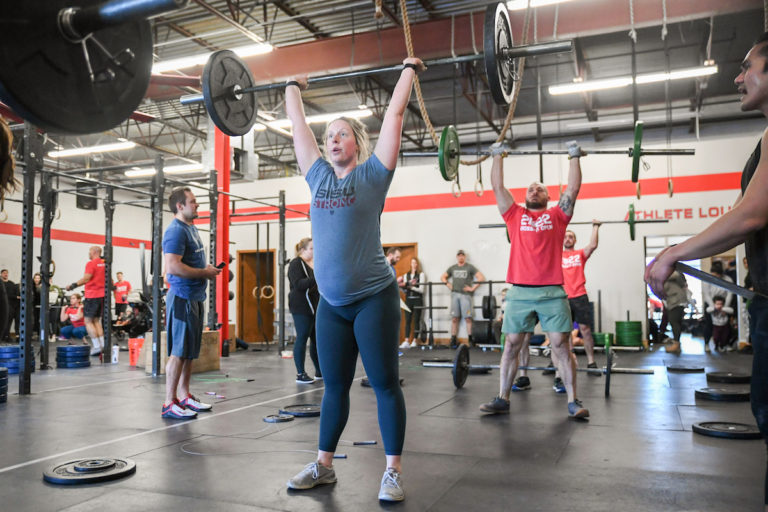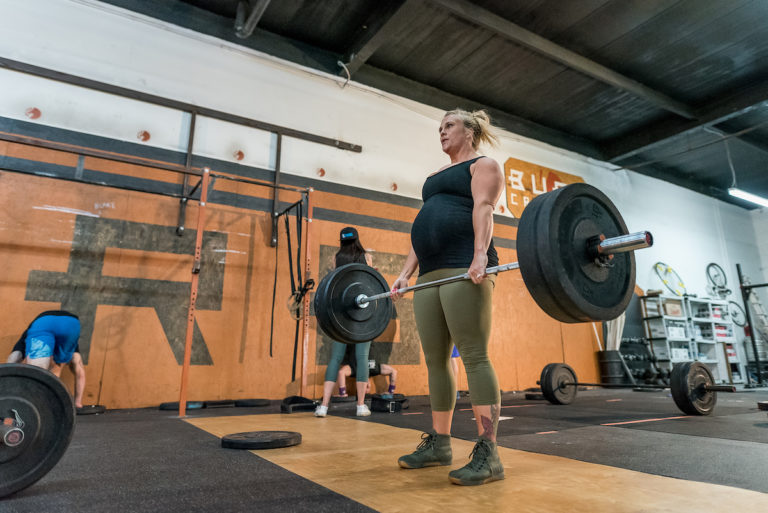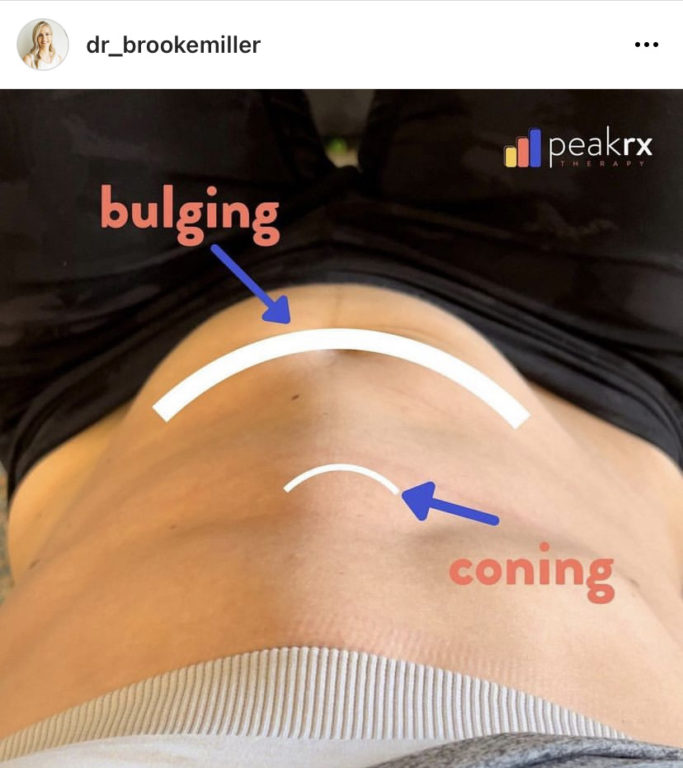Navigating CrossFit in the postpartum period can be tricky. There are many resources for trainers and athletes to help navigate CrossFit while pregnant, but when it comes to postpartum, we often forget or don’t recognize the importance of a safe return to sport. There are no official rules or parameters, and for many, postpartum care is often lacking. Just like every pregnancy is different, every labor, delivery, and recovery is different. With every athlete coming from a diverse athletic background, it’s nearly impossible to set specific and universal standards for a return to the gym after having a baby.
 A postpartum OBGYN visit typically occurs between four and six weeks after giving birth. At that point, the doctor may release the athlete to return to normal activity and the gym. Athletes and trainers alike are left wondering what “normal activity” means, especially as it relates to CrossFit! It’s very enticing for an eager athlete to jump back in right where they left off. Without proper guidance, however, they might attempt to lift loads they were once comfortable with and hastily pursue gymnastics skills and abdominal work in an effort to regain their “pre-pregnancy body.”
A postpartum OBGYN visit typically occurs between four and six weeks after giving birth. At that point, the doctor may release the athlete to return to normal activity and the gym. Athletes and trainers alike are left wondering what “normal activity” means, especially as it relates to CrossFit! It’s very enticing for an eager athlete to jump back in right where they left off. Without proper guidance, however, they might attempt to lift loads they were once comfortable with and hastily pursue gymnastics skills and abdominal work in an effort to regain their “pre-pregnancy body.”
While there are no clear timelines, standards, or rules, there are a couple of actions trainers can recommend to every postpartum CrossFit athlete.
Find a Physical Therapist Who Specializes in Pelvic Floor Rehabilitation
In America, all 50 states are direct access, meaning you can see a physical therapist without a referral from a doctor. Once you’ve found a qualified provider, the PT can evaluate pelvic floor strength, determine whether there is any diastasis recti (separation of the abdominal muscles), identify any prolapse, assess pelvic alignment, and make individual recommendations regarding a return to sport. The PT will help guide the athlete through specific pelvic floor and abdominal exercises that are safe and appropriate, as well as educate them on optimal breathing and posture — both of which will help the athlete return to CrossFit safely. As a trainer working with postpartum athletes, having a good relationship with a physical therapist will be a valuable resource as you help your athlete navigate their reintroduction to CrossFit.
(Note: Just as you will find many physicians and OBGYNs who are not CrossFit friendly, you will also find physical therapists who will recommend a far more conservative approach to a return to play than is necessary. Ideally, you and your athlete can build relationships with PTs who believe in CrossFit, understand its importance during pregnancy and in the postpartum period, and will make the road back exciting rather than something to fear.)
Don’t Forget About Mental Health
It’s important to remember the psychological and physical aspects of returning to CrossFit after giving birth. The postpartum body has just been through a tremendous change. The weeks following birth are HARD! Sleep deprivation, hormonal fluctuations, body changes, and adjusting to a new normal with a newborn can be extremely physically and emotionally challenging regardless of how the birth unfolded. For those who were able to work out through pregnancy, it will take time to rebuild core and pelvic floor strength — a potentially emotional process. It’s important for trainers to be sensitive and help encourage their athletes, find small successes to celebrate, and remind them that patience is necessary! Many who jump back into group classes may get frustrated or discouraged, or find themselves playing the compare game with others or to where they were pre-pregnancy. Set your athletes up for success by giving them predetermined scaling options that will allow them to focus on form versus loads or scores. Slow increases in weight will help your athlete feel and see progress. Turning workouts into AMRAPs and keeping the movements simple with a focus on form over intensity will help your athletes find success and enjoyment.
Rebuild From the Ground Up

In their first couple of weeks back in the gym, focus on helping your athlete rebuild a good base of strength and form. After birth, the abdominal muscles, pelvic floor, breathing patterns, and even posture have all changed. It’s likely the athlete developed some compensatory movement patterns if they continued to train CrossFit throughout pregnancy with a growing belly. Now is the time to refocus on moving well under lighter loads. Remember that the pelvic floor and abdominals are weak and stretched. If the athlete is breastfeeding, relaxin, a hormone that helps relax a woman’s body for labor and delivery by loosening the pelvis’ ligaments, bones, and muscles, is still present and making the joints more mobile. These factors put athletes at risk for injury until core strength improves. The good news? Squats and deadlifts are great ways to strengthen your core! It’s important to start light and gradually add load as the athlete tolerates. At the same time, adding in some accessory work to strengthen the glutes and hip abductors and adductors will help tremendously. Movements like good mornings, GHD hip extensions, and banded side-stepping are a few you can incorporate. The focus during this time is moving WELL. You can add the intensity piece once they consistently demonstrate good mechanics.
Watch Your Postpartum Athletes Closely
Keep an eye out for signs that their bodies aren’t ready to handle specific exercises. The things you can ask your athlete about, or look for, are coning or doming of the abdominals (a sign that the abdominal muscles have separated), and any leaking, pain, or pressure in the pelvic floor, abdominals, or incision sites. There is no timeline for the reintroduction of exercises, but there are some movements postpartum athletes may choose to avoid for the first 12 weeks. Keep in mind, these vary for each athlete.
Exercises that tend to stress the healing pelvic floor include anything with impact or weightlifting that causes the athlete to strain or bear down. Exercises like box jumps, jump rope, running, plyometric warm-ups, and heavy weightlifting are best to pass on until a period of basic strength has been established. And once they’re ready, gradually reintroduce those movements while paying specific attention to symptoms of any bladder leaking. Running isn’t advised until the 12-week mark after a baseline of hip, glute, and pelvic floor strength has been established. Until then, rowing, biking, and sled or stroller pushes make great modifications.
Athletes who had a C-section may need some additional healing time, as the scar can often remain sensitive to both touch and pressure. Additionally, the athlete may find hanging movements uncomfortable initially. Those who breastfeed may also find the pressure that comes with lying face down (as found in push-ups or burpees) uncomfortable. Modify and adjust according to an individual’s tolerance.

Used with permission from @dr_brookemiller
Diastasis recti, or separation of the abdominals, is normal during pregnancy, as well as postpartum. It can take up to a year for the abdominals to come back together. While the abdominals heal, there are certain exercises that may put unnecessary strain on them so you may encourage your athlete to avoid them. Any exercise that involves a plank, like push-ups and burpees, may put too much strain on the athlete in the first couple of weeks after they are cleared to return to exercise. Elevating them to a box will decrease the strain while they rebuild strength and endurance. Sit-ups and leg raises, such as L-sits or toes-to-bars, as well as any kipping motion can pose a strain in the immediate postpartum period. Keeping toes-to-bars and pull-ups strict in the first month postpartum will help reduce strain while building strength. When your athlete can perform strict toes-to-bar and pull-ups without difficulty or symptoms, gradually reintroduce the kipping motion. Keep an eye out for coning or doming when performing core exercises.
Taking caution and being mindful of the healing that is taking place during the first 12 weeks (longer for some) will pay off huge for your athletes. While running, jumping, kipping, sit-ups, impact, and heavy lifting may be out for the short term, there are many modifications you can provide for your athletes. For example, the bike or weighted sled pulls are great modifications for running. Burpees and push-ups can be modified to a box or knees to lessen the stress on the core. Focus on strict strength in the various gymnastics movements like pull-ups and toes-to-bars. For the athlete who is dying to work their abdominals, one-arm farmers carries and side planks can be a great alternative to sit-ups. Remember that the most potent abdominal and core exercises are isometric in nature. That is, when the abdominals need to resist movement of the spine while there is action at the hip. This is found in each of the nine foundational movements we teach at the Level 1 Seminar, as well as most exercises we see in CrossFit!
Once your postpartum athlete has built a good foundation of strength, gradually add load, stress, and intensity back into their programming. Monitor symptoms and establish a relationship with your local physical therapist for guidance.
Each pregnant and postpartum athlete will have a different path back, but if you do the four things outlined in this article, you can play a big part in helping them to return to play and feel strong and supported throughout the process.
About the Author
Melissa Reed, PT, MSPT, CF-L3 has over 18 years experience as a Physical Therapist working with CrossFit athletes, and women during pregnancy and post partum. A mom to 3, she has used CrossFit to prepare and recover from child birth with each pregnancy. She is a flowmaster for the CrossFit Level 1 and 2 Seminar staff and is a 12yr affiliate owner. She runs her practice Reed Fitness & Physical Therapy out of CrossFit Anna Maria in Bradenton Beach Florida with her husband and 3 kids.